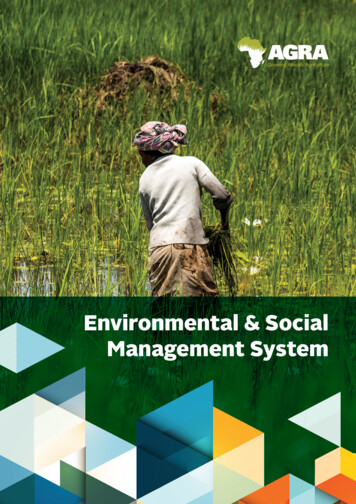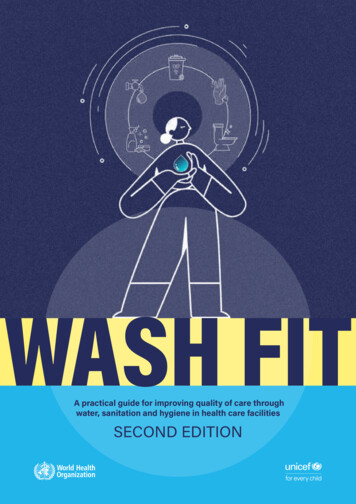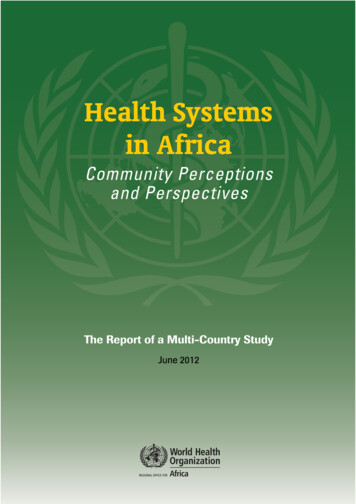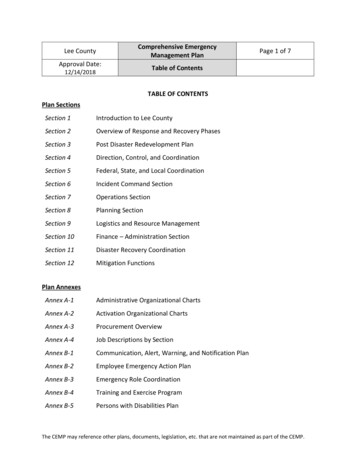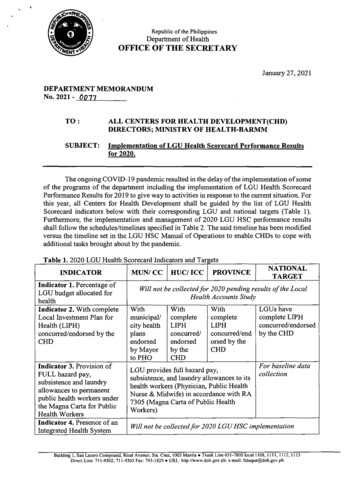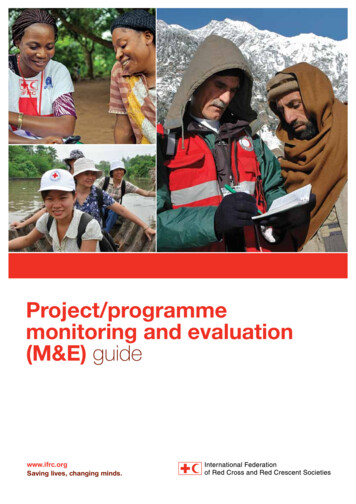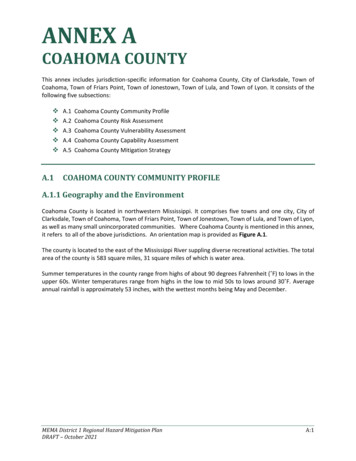
Transcription
ANNEX ACOAHOMA COUNTYThis annex includes jurisdiction-specific information for Coahoma County, City of Clarksdale, Town ofCoahoma, Town of Friars Point, Town of Jonestown, Town of Lula, and Town of Lyon. It consists of thefollowing five subsections: A.1A.1 Coahoma County Community ProfileA.2 Coahoma County Risk AssessmentA.3 Coahoma County Vulnerability AssessmentA.4 Coahoma County Capability AssessmentA.5 Coahoma County Mitigation StrategyCOAHOMA COUNTY COMMUNITY PROFILEA.1.1 Geography and the EnvironmentCoahoma County is located in northwestern Mississippi. It comprises five towns and one city, City ofClarksdale, Town of Coahoma, Town of Friars Point, Town of Jonestown, Town of Lula, and Town of Lyon,as well as many small unincorporated communities. Where Coahoma County is mentioned in this annex,it refers to all of the above jurisdictions. An orientation map is provided as Figure A.1.The county is located to the east of the Mississippi River suppling diverse recreational activities. The totalarea of the county is 583 square miles, 31 square miles of which is water area.Summer temperatures in the county range from highs of about 90 degrees Fahrenheit ( F) to lows in theupper 60s. Winter temperatures range from highs in the low to mid 50s to lows around 30 F. Averageannual rainfall is approximately 53 inches, with the wettest months being May and December.MEMA District 1 Regional Hazard Mitigation PlanDRAFT – October 2021A:1
ANNEX A: COAHOMA COUNTYFIGURE A.1: COAHOMA COUNTY ORIENTATION MAPA.1.2 Population and DemographicsAccording to the 2020 Census, Coahoma County has a population of 21,390 people. The county has seena decrease in population between 2010 and 2020, and the population density is 39 people per squaremile. Population counts from the U.S. Census Bureau for 2000, 2010, and 2020 for the county andparticipating jurisdictions are presented in Table A.1.TABLE A.1: POPULATION COUNTS FOR COAHOMA COUNTYJurisdictionCoahoma CountyClarksdaleCoahoma (town)2000 CensusPopulation2010 CensusPopulation2020 CensusPopulation% 214,903-20.5%325377229-64.6%Friars 9%370298204-46.1%LulaMEMA District 1 Regional Hazard Mitigation PlanDRAFT – October 2021A:2
ANNEX A: COAHOMA COUNTY2000 CensusPopulationJurisdictionLyon2010 CensusPopulation418Unincorporated Area5,683Source: United States Census Bureau, 2000, 2010, and 2020 Census2020 CensusPopulation% Change2010-2020350296-18.2%4,6663,900-16.4%Based on the 2020 Census, the median age of residents of Coahoma County is 34.8 years. The racialcharacteristics of the county are presented in Table A.2. Black or African American make up the majorityof the population in the county, accounting for over 75 percent of the population.TABLE A.2: DEMOGRAPHICS OF COAHOMA COUNTYAmericanIndian iveHawaiianor 20)Two ercent(2020)*JurisdictionWhite,Percent(2020)Black orAfricanAmerican,Percent(2020)Coahoma 0.1%0.7%0.0%0.8%1.8%1.4%Coahoma (town)0.9%98.7%0.4%0.0%0.0%0.0%0.0%0.0%Friars .3%19.3%0.0%0.0%*Hispanics may be of any race, so also are included in applicable race categoriesSource: United States Census Bureau, 2020 CensusA.1.3 HousingAccording to the 2010 U.S. Census, there were 10,792 housing units in Coahoma County. The 2020 U.S.Census housing information for the county and six municipalities is also presented in Table A.3. As shownin the table, there were 10,162 housing units in Coahoma County. The table also includes the percentageof housing classified as mobile homes or other dwelling, and the median home value for 2015-2019.TABLE A.3: HOUSING CHARACTERISTICS OF COAHOMA COUNTYJurisdictionCoahoma CountyClarksdaleHousing Units(2020)Mobile Homesor other,Percent (2020)Median HomeValue (2015-2019)10,79210,1627.4% 89,800Housing Units(2010)7,2586,9842.4% 81,100Coahoma (town)15011521.8% 32,500Friars Point46740913.6% 84,700Jonestown47640417.3% 52,000Lula1381157.8% 43,800Lyon1811651.5% 97,000Source: United States Census Bureau, 2010 and 2020 Census and 2015-2019 American Community Survey 5-Year EstimatesMEMA District 1 Regional Hazard Mitigation PlanDRAFT – October 2021A:3
ANNEX A: COAHOMA COUNTYA.1.4 InfrastructureTRANSPORTATIONIn Coahoma County, U.S. Highway 49 provides access to the north and south. U.S. Route 61, which crossesnorth and south, travels through Coahoma City. State Highway 1 and State Highway 6 provide accesswithin Coahoma County.Fletcher Field is located northeast of Clarksdale City and provides general aviation as a public use airport.Shannon Field is a local airport with private facility usage located southeast of the City of Clarksdale. Theclosest international airport is in Memphis, less than 100 miles away from the county.A major freight rail lines operate within Coahoma County. MS Delta is a Class III Local railway that operateswithin Coahoma County from the Town of Jonestown to the City of Clarksdale through the County toTallahatchie County, Mississippi. Business and industries rely on this line along with various other majorhighway routes as distribution of merchandises.UTILITIESElectrical power in Coahoma County is provided by different electric power association. The City ofClarksdale electric power association serves Coahoma County. Entergy Utility serves Coahoma County.Water and sewer service is provided by all of the participating towns and/or community basedassociations, but unincorporated areas often rely on septic systems and wells in the Coahoma County.COMMUNITY FACILITIESThere are a number of buildings and community facilities located throughout Coahoma County. Accordingto the data collected for the vulnerability assessment (Section 6.4.1), there are 7 fire stations, 5 policestations, and 22 schools located within the county.There is one hospital located in Coahoma County. Delta Health Northwest Regional Mississippi is a 195bed medical-surgical hospital located in Clarksdale City of Coahoma County.Educational institutions are found throughout Coahoma County. Coahoma Community College is a twoyear coeducational community college within Coahoma County. Coahoma Community College providesathletic opportunities for students and sporting events for county residents.There are multiple museums in Coahoma County such as Delta Blues Museum, North Delta Museum, andRock ‘n’ Roll Blues Heritage Museum. Other recreational opportunities include the Coahoma County ExpoCenter hosts livestock events throughout the year along with festivals, concerts, racing events,conventions, and flea markets. There is RV parking available with full access to necessities. Isle of CapriEntertainment Resort within Coahoma County offers gaming and dining. Quapaw Canoe Companyoperates within Coahoma County providing guided tours along the Lower Mississippi.MEMA District 1 Regional Hazard Mitigation PlanDRAFT – October 2021A:4
ANNEX A: COAHOMA COUNTYA.1.5 Land UseMany areas of Coahoma County are undeveloped or sparsely developed. There are several small,incorporated municipalities located throughout the county, with a few larger hubs interspersed. Theseareas are where the county’s population is generally concentrated. The incorporated areas are also wheremany of the businesses, commercial uses, and institutional uses are located. Land uses in the balance ofthe county generally consist of rural residential development, agricultural uses, and recreational areas,although there are some notable exceptions in the larger municipalities. Local land use and associatedregulations are further discussed in Section 7: Capability Assessment.North Delta Planning and Development District provides services related to regional planning, localtechnical assistance, and coordination and review of applications for federally sponsored programs withinNorthwest Mississippi. The purpose of the district is to promote economic development, encourageresponsibility short and long term community planning, and to aid in general civic, social, and economicdevelopment.A.1.6 Employment and IndustryAccording to the DATA USA, which cites source, the U.S. Census Bureau, in 2019, Coahoma County had anaverage annual employment of 8,024 workers and an average unemployment rate of 11.4 percent(compared to 6.1 percent for the state). In 2019, the most common employment sectors for those wholived in Coahoma County were in Office and Administrative Support Occupations (779 people) followedby Sales and Related Occupations (722 people); Food Preparation and Serving Related Occupations (704people); Management Occupations (655 people); Education Instruction and Library Occupations (580people). Compared to other counties, Coahoma County has an unusually high number of residentsworking as Farming, Fishing, & Forestry Occupations (4.14 times higher than expected). The averageannual median household in 2019 for Coahoma County was 29,121 compared to 45,081 in the state ofMississippi.A.2COAHOMA COUNTY RISK ASSESSMENTThis subsection includes hazard profiles for each of the significant hazards identified in Section 4: HazardIdentification as they pertain to Coahoma County. Each hazard profile includes a description of thehazard’s location and extent, notable historical occurrences, and the probability of future occurrences.Additional information can be found in Section 5: Hazard Profiles.MEMA District 1 Regional Hazard Mitigation PlanDRAFT – October 2021A:5
ANNEX A: COAHOMA COUNTYFLOOD-RELATED HAZARDSA.2.1 Dam and Levee FailureLOCATION AND SPATIAL EXTENTAccording to the Mississippi Department of Environmental Quality, there are no high hazard dams inCoahoma County, which includes all jurisdictions in Coahoma County as shown in Figure A.2 and TableA.4.1FIGURE A.2: COAHOMA COUNTY HIGH HAZARD DAM LOCATIONSSource: Mississippi Department of Environmental Quality1The list of high hazard dams obtained from the Mississippi Department of Environmental Quality was reviewed and amendedby local officials to the best of their knowledge.MEMA District 1 Regional Hazard Mitigation PlanDRAFT – October 2021A:6
ANNEX A: COAHOMA COUNTYTABLE A.4: COAHOMA COUNTY HIGH HAZARD DAMSDam NameCoahoma County UnincorporatedClarksdaleCoahomaFriars PointJonestownLulaLyonHazard PotentialNoneNoneNoneNoneNoneNoneNoneSource: Mississippi Department of Environmental QualityHISTORICAL OCCURRENCESAccording to the Mississippi State Hazard Mitigation Plan, there is no record of dam breaches in CoahomaCounty, including all jurisdictions in Coahoma County (Table A.5). However, several breach scenarios inthe region could be catastrophic.TABLE A.5: COAHOMA COUNTY DAM FAILURES (1982-2021)DateNone ReportedNone ReportedNone ReportedNone ReportedNone ReportedNone ReportedNone ReportedJurisdictionsStructure iars PointJonestownLulaLyonCause of Failure------------------Source: Mississippi Department of Environmental QualityPROBABILITY OF FUTURE OCCURRENCESGiven the current dam inventory and historic data, a dam breach is unlikely (less than 1 percent annualprobability) in the future. As has been demonstrated in the past, regular monitoring is necessary toprevent these events.A.2.2 ErosionLOCATION AND SPATIAL EXTENTErosion in Coahoma County is typically caused by flash flooding events. Unlike coastal areas, areas ofconcern for erosion in Coahoma County are primarily rivers/streams and reservoirs. Generally, vegetationhelps to prevent erosion in the area, and it is not an extreme threat to the county.MEMA District 1 Regional Hazard Mitigation PlanDRAFT – October 2021A:7
ANNEX A: COAHOMA COUNTYAt this time, there is limited data available on localized areas of erosion so it is not possible to depictextent on a map.HISTORICAL OCCURRENCESSeveral sources were vetted to identify areas of erosion in Coahoma County. This includessearching local newspapers, interviewing local officials, and reviewing previous hazardmitigation plans.1UUU4PR 2021The Memphis District recently awarded a task order to restore existing revetment and repairover-steepened banks along the Mississippi River in Coahoma County, Mississippi, and PhillipsCounty, Arkansas. A total of 1,344,000 was awarded on the current River Repairs. (Source: USArmy Corps of Engineers Headquarters Website April 2021).US Army Corps of Engineers reported erosion and scouring along banks of the MS River in CoahomaCounty due to the 2019 Mississippi River Flood. No major historical erosion occurrences have beenfound. Data is limited on the extent and impact of erosion in Coahoma County and all jurisdictions inCoahoma County.MEMA District 1 Regional Hazard Mitigation PlanDRAFT – October 2021A:8
ANNEX A: COAHOMA COUNTYPROBABILITY OF FUTURE OCCURRENCESErosion remains a natural, dynamic, and continuous process for Coahoma County, and it will continue tooccur. The annual probability level assigned for erosion is likely (between 10 and 100 percent annually).A.2.3 FloodLOCATION AND SPATIAL EXTENTThere are areas in Coahoma County that are susceptible to flood events. Special flood hazard areas in thecounty were mapped using Geographic Information System (GIS) and FEMA Digital Flood Insurance RateMaps (DFIRM).2 This includes Zone A (1-percent annual chance floodplain) and Zone AE (1-percent annualchance floodplain with elevation). According to GIS analysis, of the 585.7 square miles that make upCoahoma County, there are 188.5 square miles of land in zones A and AE (1-percent annual chancefloodplain/100-year floodplain).These flood zone values account for 32.2 percent of the total land area in Coahoma County. It is importantto note that while FEMA digital flood data is recognized as best available data for planning purposes, itdoes not always reflect the most accurate and up-to-date flood risk. Flooding and flood-related lossesoften do occur outside of delineated special flood hazard areas. Figure A.3 and Figure A.3.1 illustrate thelocation and extent of currently mapped special flood hazard areas for Coahoma County based on bestavailable FEMA Digital Flood Insurance Rate Map (DFIRM) data.2 The county-levelDFIRM data used for Coahoma County were updated in 2012.MEMA District 1 Regional Hazard Mitigation PlanDRAFT – October 2021A:9
ANNEX A: COAHOMA COUNTYFIGURE A.3: SPECIAL FLOOD HAZARD AREAS IN COAHOMA COUNTYSource: Federal Emergency Management AgencyMEMA District 1 Regional Hazard Mitigation PlanDRAFT – October 2021A:10
ANNEX A: COAHOMA COUNTYFIGURE A.4.1: SPECIAL FLOOD HAZARD AREAS IN COAHOMA COUNTYSource: Federal Emergency Management AgencyHISTORICAL OCCURRENCESFloods were at least partially responsible for nine disaster declarations in Coahoma County in 1973, 1990,twice in 1991, 2001, twice in 2011, twice in 2016, 2019, and 2020.3 Information from the National ClimaticData Center was used to ascertain additional historical flood events. The National Climatic Data Centerreported a total of 23 events in Coahoma County since 1997.4 A summary of these events is presented inTable A.6. These events accounted for 1,938,000 in property damage. Specific information on floodevents, including date, type of flooding, and deaths and injuries, can be found in Table A.7.TABLE A.6: SUMMARY OF FLOOD OCCURRENCES IN COAHOMA COUNTYLocationClarksdaleCoahoma (town)Number e (2021) 1,137,000 0AnnualizedProperty Losses 47,375 03A complete listing of historical disaster declarations can be found in Section 4: Hazard Identification.These flood events are only inclusive of those reported by the National Climatic Data Center (NCDC) from 1996 through May2021. It is likely that additional occurrences have occurred and have gone unreported. As additional local data becomes available,this hazard profile will be amended.4MEMA District 1 Regional Hazard Mitigation PlanDRAFT – October 2021A:11
ANNEX A: COAHOMA COUNTYLocationNumber ofOccurrencesDeaths/Injuries300140/00/00/00/00/0 26,000 0 0 0 775,000 1,083 0 0 0 32,292230/0 1,938,000 80,750Friars PointJonestownLulaLyonUnincorporated AreaCOAHOMA COUNTYTOTALPropertyDamage (2021)AnnualizedProperty LossesSource: National Climatic Data CenterTABLE A.7: HISTORICAL FLOOD EVENTS IN COAHOMA perty /20095/25/20104/20/20113/10/20166/10/2021Flash FloodFlash FloodFlash FloodFlash FloodFlash FloodFlash FloodFlash FloodFlash FloodFlash FloodFlash FloodFlash FloodFlash FloodFlash FloodFloodFlash ------7/14/20025/2/20097/30/2009Flash FloodFlash FloodFlash Flood0/00/00/0----------------7/23/2014Flash Flood0/0 oodFlood0/00/00/00/0 6,783 13,565 13,565 801,004 1,497 6,975 20,347 1,335 13,354 6,528 0 0 111,580 0 0 0 0 1,000,000 150,000Coahoma (town)None Reported--Friars PointFRIARS PTFRIARS PTFRIARS PT 1,335 0 27,995JonestownNone ReportedLulaNone ReportedLyonLYONUnincorporated AreaCOAHOMA (ZONE)COAHOMA (ZONE)COAHOMA (ZONE)HILLHOUSEMEMA District 1 Regional Hazard Mitigation PlanDRAFT – October 2021A:12
ANNEX A: COAHOMA COUNTYLocationDateTypeDeaths/InjuriesProperty DamageTable 4.7 updated thru July 2021.Source: National Climatic Data CenterHISTORICAL SUMMARY OF INSURED FLOOD LOSSESThe below information regarding repetitive loss and severe repetitive is the latest available data for this2021 plan update due to directive regarding sharing NFIP information. According to FEMA flood insurancepolicy records as of June 2016, there have been 344 flood losses reported in Coahoma County throughthe National Flood Insurance Program (NFIP) since 1978, totaling almost 6.6 million in claims payments.A summary of these figures for the county is provided in Table A.8. It should be emphasized that thesenumbers include only those losses to structures that were insured through the NFIP policies, and for lossesin which claims were sought and received. It is likely that many additional instances of flood loss inCoahoma County were either uninsured, denied claims payment, or not reported.TABLE A.8: SUMMARY OF INSURED FLOOD LOSSES IN COAHOMA COUNTYNumber ofPoliciesFlood LossesClarksdaleCoahoma (town)Friars PointJonestownLulaLyonUnincorporated Area91024121245200505282 1,387,465 0 0 69,185 0 162,782 4,935,684COAHOMA COUNTY TOTAL224344 6,555,116LocationClaims PaymentsSource: National Flood Insurance ProgramREPETITIVE LOSS PROPERTIESAccording to the Mississippi Emergency Management Agency, there are 40 non-mitigated repetitive lossproperties located in Coahoma County, which accounted for 107 losses and almost 1.1 million in claimspayments under the NFIP. The average claim amount for these properties is 9,882. Of the 40 properties,37 are single family, 1 is multi-family, and 2 are non-residential. Without mitigation, these properties willlikely continue to experience flood losses. Table A.9 presents detailed information on repetitive lossproperties and NFIP claims and policies for Coahoma County.TABLE A.9: REPETITIVE LOSS PROPERTIES IN COAHOMA COUNTYLocationNumber ofPropertiesClarksdale10Coahoma (town)Friars Point60Jonestown4Types ofPropertiesNumberof Losses10 singlefamily6 singlefamily-4 singlefamilyMEMA District 1 Regional Hazard Mitigation PlanDRAFT – October eragePayment28 201,668 57,324 258,992 9,250160 77,923 0 21,714 0 99,637 0 6,227 08 28,321 17,947 46,268 5,784A:13
ANNEX A: COAHOMA COUNTYLocationNumber ofPropertiesLula2Lyon2Unincorporated Area16COAHOMACOUNTY TOTAL40Types ofPropertiesNumberof Losses2 singlefamily1 singlefamily, 1multifamily14 singlefamily, lPaymentsAveragePayment4 30,018 0 30,018 7,5054 10,914 11,768 22,682 5,67147 510,459 89,295 599,755 12,761 859,303 198,048 1,057,352 9,882107Source: National Flood Insurance ProgramPROBABILITY OF FUTURE OCCURRENCESFlood events will remain a threat in Coahoma County, and the probability of future occurrences willremain highly likely (100 percent annual probability). The participating jurisdictions and unincorporatedareas have risk to flooding, though not all areas will experience flood. The probability of future floodevents based on magnitude and according to best available data is illustrated in the figure above, whichindicates those areas susceptible to the 1-percent annual chance flood (100-year floodplain).It can be inferred from the floodplain location maps, previous occurrences, and repetitive loss propertiesthat risk varies throughout the county. For example, areas along the western border of the county havemore floodplain and thus a higher risk of flood than the rest of the county. Flood is not the greatest hazardof concern but will continue to occur and cause damage. Therefore, mitigation actions may be warranted,particularly for repetitive loss properties.FIRE-RELATED HAZARDSA.2.4 DroughtLOCATION AND SPATIAL EXTENTDrought typically covers a large area and cannot be confined to any geographic or political boundaries.District 1 Regional Hazard Mitigation Council determined that all jurisdictions in Coahoma County couldbe equally impacted by drought conditions, making the spatial extent potentially widespread. It is alsonotable that drought conditions typically do not cause significant damage to the built environment butmay exacerbate wildfire conditions.HISTORICAL OCCURRENCESAccording to the U.S. Drought Monitor, Coahoma County had drought levels of Severe or worse in 9 ofthe last 22 years (January 2000-October 2021). Figure 8.4 shows the most severe drought classificationfor each year, according to U.S. Drought Monitor classifications. It should be noted that the U.S. DroughtMonitor also estimates what percentage of the county is in each classification of drought severity. ForMEMA District 1 Regional Hazard Mitigation PlanDRAFT – October 2021A:14
ANNEX A: COAHOMA COUNTYexample, the most severe classification reported may be exceptional but a majority of the county mayactually be in a less severe condition.FIGURE 8.4: HISTORICAL DROUGHT OCCURRENCES IN COAHOMA COUNTYAbnormally Dry (D0) Moderate Drought (D1) Severe Drought (D2) Extreme Drought (D3) Exceptional Drought (D4)Drought.govSome additional anecdotal information and table of historical drought occurrences were provided fromthe National Climatic Data Center for Coahoma County and all jurisdictions.Summer 2007 – Drought conditions began in early April across portions of Northeast Mississippi andexpanded to North Central Mississippi by the end of April. Drought conditions continued throughout thesummer months through October and at times reached exceptional conditions. The drought impactedagricultural and hydrological interests of the area. Burn bans in some locations were issued due to thelack of rainfall.Summer 2010 to Spring 2011 – Below normal rainfall from June 2010 until April 2011 resulted in droughtacross Northwest Mississippi. The biggest impact of the drought was on agriculture as many crops suffereddue to the lack of rainfall. Many pastures were in poor condition forcing farmers to feed livestock withbaled hay. Hydrological concerns started to become an issue by the end of September into March as manylake and river levels dropped. Lack of moisture in the ground also caused several pipes to burst in theregion. Burn bans were issued for most of North Mississippi.MEMA District 1 Regional Hazard Mitigation PlanDRAFT – October 2021A:15
ANNEX A: COAHOMA COUNTYSummer 2012 – Below normal rainfall fell during the month of July across North Mississippi. Many cropsthat were planted during the spring struggled to grow due to lack of water. Many pastures were in poorcondition forcing farmers to feed cattle baled hay. Lake and river levels dropped to low levels. Burn banswere issued for many counties as a result of the dry conditions. Drought conditions improved during themonth of October.September 2013 – A prolonged dry spell during the latter part of the summer produced severe droughtconditions across portions of Northwest Mississippi by the beginning of September. However, droughtconditions improved by the latter part of the month as several periods of rain occurred from passing coldfronts. Little damage occurred to crops as crops were being harvested at the time. Cattle possibly had ahard time finding adequate water sources as rivers and lakes were at low levels.Fall 2015 – Abnormally dry conditions during the latter part of the summer into the early part of fall ledto moderate drought conditions over portions of Northwest Mississippi during October and November.The drought had little impact with agriculture as the dry weather allowed crops to be harvested and winterwheat to be planted. However, the dry conditions did elevate the risk of wildfires. River and lake levelswere also at low levels.Summer to Fall 2016 – Moderate to severe drought experienced in the MEMA District 1 Region.HISTORICAL DROUGHT OCCURRENCES IN COAHOMA COUNTY (2010 – 2021)LocationDateTypeMagnit Death Injury ought000.00K0.00KMEMA District 1 Regional Hazard Mitigation PlanDRAFT – October 2021CropDamage0.00KA:16
ANNEX A: COAHOMA 00K0.00K000.00K0.00KSource: National Climatic Data CenterPROBABILITY OF FUTURE OCCURRENCESBased on historical occurrence information, it is assumed that Coahoma County has a probability level oflikely (between 10 and 100 percent annual probability) for future drought events. However, the extent(or magnitude) of drought and the amount of geographic area covered by drought, varies with each year.Historic information indicates that there is a much lower probability for extreme, long-lasting droughtconditions.A.2.5 LightningLOCATION AND SPATIAL EXTENTLightning occurs randomly, therefore it is impossible to predict where and with what frequency it willstrike. District 1 Regional Hazard Mitigation Council determined that all jurisdictions in Coahoma Countycould be equally impacted by lightning.MEMA District 1 Regional Hazard Mitigation PlanDRAFT – October 2021A:17
ANNEX A: COAHOMA COUNTYHISTORICAL OCCURRENCESAccording to the National Climatic Data Center, there has been one recorded lightning event in CoahomaCounty since 1997.5 This event resulted in almost 10,000 in property damages, as listed in summary TableA.100. Furthermore, lightning caused four deaths in Coahoma County. Detailed information on historicallightning events can be found in Table A.111.It is certain that more than one event has impacted the county. Many of the reported events are thosethat cause damage, and it should be expected that damages are likely much higher for this hazard thanwhat is reported.TABLE A.10: SUMMARY OF LIGHTNING OCCURRENCES IN COAHOMA COUNTYNumber ofOccurrencesDeaths/InjuriesClarksdaleCoahoma (town)Friars PointJonestownLulaLyonUnincorporated Area00010000/00/00/04/00/00/00/0 0 0 0 10,000 0 0 0 0 0 0 435 0 0 0COAHOMA COUNTYTOTAL14/0 10,000 435LocationPropertyDamage (2021)AnnualizedProperty LossesSource: National Climatic Data CenterTABLE A.11: HISTORICAL LIGHTNING OCCURRENCES IN COAHOMA ---------------------DetailsClarksdaleNone ReportedCoahoma (town)None ReportedFriars PointNone ReportedJonestownJONESTOWN 10,000A house was badly damaged by a fire started bylightning. Four children ranging in age from 18months to 4 years old were killed in the fire.3/2/19970/0----------------LulaNone ReportedLyonNone ReportedUnincorporated Area5These lightning events are only inclusive of those reported by the National Climatic Data Center (NCDC) from 1996 throughMay 2021. It is certain that additional lightning events have occurred in Coahoma County. As additional local data becomesavailable, this hazard profile will be amended.MEMA District 1 Regional Hazard Mitigation PlanDRAFT – October 2021A:18
ANNEX A: COAHOMA COUNTYLocationDateDeaths/InjuriesNone Reported-Source: National Climatic Data CenterPropertyDamage--Details----PROBABILITY OF FUTURE OCCURRENCESAlthough there was not a high number of historical lightning events reported in Coahoma County via NCDCdata, it is a regular occurrence accompanied by thunderstorms. In fact, lightning events will assuredlyhappen on an annual basis, though not all events will cause damage. According to Vaisala’s U.S. NationalLightning Detection Network (NLDN), Coahoma County is located in an area of the country thatexperienced an average of 4 to 12 lightning flashes per square kilometer per year between 2005 and 2018.Therefore, the probability of future events is highly likely (100 percent annual
A.1 Coahoma County Community Profile A.2 Coahoma County Risk Assessment A.3 Coahoma County Vulnerability Assessment A.4 Coahoma County Capability Assessment A.5 Coahoma County Mitigation Strategy A.1 COAHOMA COUNTY COMMUNITY PROFILE A.1.1 Geography and the Environment Coahoma County is located in northwestern Mississippi.
